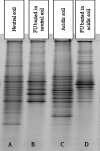Fungal communities associated with degradation of polyester polyurethane in soil
- PMID: 17660302
- PMCID: PMC2074895
- DOI: 10.1128/AEM.01083-07
Fungal communities associated with degradation of polyester polyurethane in soil
Abstract
Soil fungal communities involved in the biodegradation of polyester polyurethane (PU) were investigated. PU coupons were buried in two sandy loam soils with different levels of organic carbon: one was acidic (pH 5.5), and the other was more neutral (pH 6.7). After 5 months of burial, the fungal communities on the surface of the PU were compared with the native soil communities using culture-based and molecular techniques. Putative PU-degrading fungi were common in both soils, as <45% of the fungal colonies cleared the colloidal PU dispersion Impranil on solid medium. Denaturing gradient gel electrophoresis showed that fungal communities on the PU were less diverse than in the soil, and only a few species in the PU communities were detectable in the soil, indicating that only a small subset of the soil fungal communities colonized the PU. Soil type influenced the composition of the PU fungal communities. Geomyces pannorum and a Phoma sp. were the dominant species recovered by culturing from the PU buried in the acidic and neutral soils, respectively. Both fungi degraded Impranil and represented >80% of cultivable colonies from each plastic. However, PU was highly susceptible to degradation in both soils, losing up to 95% of its tensile strength. Therefore, different fungi are associated with PU degradation in different soils but the physical process is independent of soil type.
Figures



References
-
- Alef, K., and P. Nannipieri. 1995. Methods in applied soil microbiology and biochemistry. Academic Press, London, United Kingdom.
-
- An, Y. H., and R. J. Friedman. 1998. Concise review of mechanisms of bacterial adhesion to biomaterial surfaces. J. Biomed. Mater. Res. 43:338-348. - PubMed
-
- Barratt, S. R., A. R. Ennos, M. Greenhalgh, G. D. Robson, and P. S. Handley. 2003. Fungi are the predominant micro-organisms responsible for the degradation of soil-buried polyester polyurethane over a range of soil water holding capacities. J. Appl. Microbiol. 94:1-8. - PubMed
Publication types
MeSH terms
Substances
LinkOut - more resources
Full Text Sources
Medical
Molecular Biology Databases

